 |
History of Georgia Evidence for the earliest occupation of the territory of present day Georgia goes back to c. 1.8 million years ago, as evident from the excavations of Dmanisi in the south-eastern part of the country. This is the oldest evidence of humans anywhere in the world outside Africa. Later prehistoric remains (Acheulian, Mousterian and the Upper Palaeolithic) are known from numerous cave and open-air sites in Georgia. The earliest agricultural Neolithic occupation is dated sometime between 6000 and 5000 BC. In the Chalcolithic period of the fourth and third millennia BC, Georgia and Asia Minor were home to the Kura-Araxes culture, giving way in the second millennium BC. to the Trialeti culture |
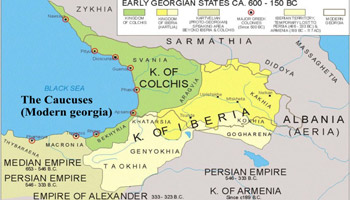 |
Early Georgian States of Colchis and Iberia. The Kingdom of Kartli (known as Iberia in the Greek-Roman literature) was founded around 300 BC by Parnavaz I, the first ruler of the Parnavazid dynasty. |
 |
Roman Empire Kingdom of Lazica This close association with Armenia brought upon the country an invasion (65 BC) by the Roman general Pompey, who was then at war with Mithradates VI of Pontus, and Armenia; but Rome did not establish her power permanently over Iberia |
 |
Christianity as a State Religion since 337 AD. King Mirian III established Christianity in Georgia as the official state religion in 337The eastern Georgian Kingdom of Iberia became one of the first states in the world to convert to Christianity in 327 AD, when the King of Iberia Mirian III established it as the official state religion. This adoption of Christianity tied the kingdom to the Byzantine Empire, which exerted strong cultural influence over it. During the 4th and most of the 5th centuries, Iberia (known also as the Kingdom of Kartli) was under Persian control. The Kingdom was abolished and the country was ruled by the governors appointed by the Shahs. At the end of the 5th century though, Prince Vakhtang I Gorgasali orchestrated an anti-Persian uprising and restored Iberian statehood, proclaiming himself the King |
 |
King of Georgia David the Builder Kingdom of Georgia during King David the Builder in 1124.The struggle against the Seljuq invaders in Georgia was led by the young King David IV of the Bagrationi royal family, who inherited the throne in 1089 at the age of 16 after the abdication of his father George II Bagrationi. Soon after coming to power, David created the regular army and peasant militia in order to be able to resist Seljuq colonization of his country. |
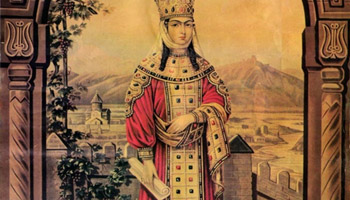 |
Queen Tamar of Georgia. The reign of Queen Tamar represented the peak of Georgia s might in the whole history of the nation. |
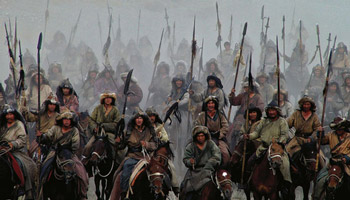 |
Mongol invasion Mongol invasion and decline of the Georgian KingdomIn the 1220s, the South Caucasus and Asia Minor faced the invasion of the Mongols. |
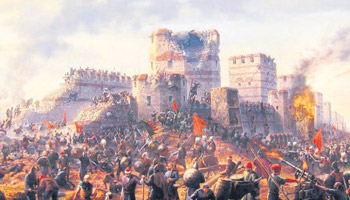 |
Fall of Constantinople and isolation of Georgia. In 15th century the whole area changed dramatically in all possible aspects: linguistic, cultural, political, etc. During that period the Kingdom of Georgia turned into an isolated, fractured Christian enclave, a relic of the faded East Roman epoch surrounded by Muslim, predominantly Turco-Iranian-Arabic world. |
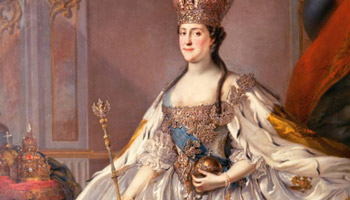 |
Georgia,Russia, Catharina the Great King Erekle II The emergence of a third imperial power to the north, Christian Russia, made the latter an increasingly tempting choice.King Erekle II Erekle II, king of Kartli-Kakheti from 1762 to 1798, turned towards Russia for protection against Ottoman and Persian attacks. The Russian empress Catherine the Great was keen to have the Georgians as allies in her wars against the Turks, but sent only meagre forces to help them In 1783 Erekle signed the Treaty of Georgievsk with Russia. |
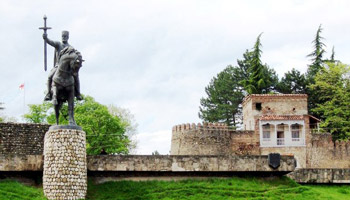 |
But when another Russo-Turkish War broke out in 1787, Erekle maintained diplomatic contacts with Ottoman liege Suleiman pasha from Akhaltsikhe and signed a separate treaty with him. This treaty was ratified by the sultan in the summer of 1787. Therefore the Russians withdrew their troops from the region for use elsewhere, leaving Erekles kingdom unprotected. In 1795, the Persian shah, Agha Mohammed Khan, invaded the country and burnt the capital, Tbilisi, to the ground. |
 |
Annexion of Georgia
On January 8, 1801, Tsar Paul I of Russia signed a decree on the incorporation of Georgia (Kingdom of Kartli-Kakheti) within the Russian EmpireA part of the Georgian nobility did not accept the decree until April 1802 when General Knorring compassed the nobility in Tbilisis Sioni Cathedral and forced them to take an oath on the imperial crown of Russia. Those who disagreed were arrested temporarily. Georgia was reunified for the first time in centuries but had lost its independence. The 11th Red Army enters Tbilisi. 25 February 1921 |
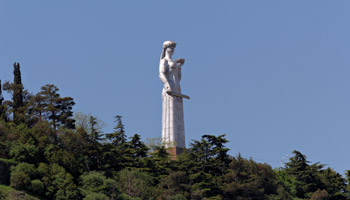 |
|
 |


